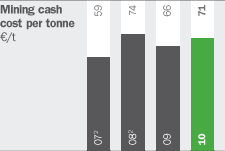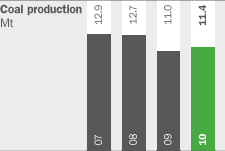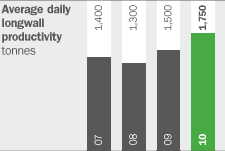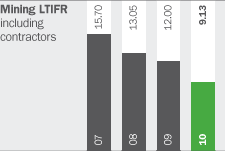Key Performance Indicators ('KPIs')
NWR uses a range of financial and non-financial KPIs to help measure and manage its performance. These KPIs reflect the Company’s continuous focus on efficiency, cost control and safety across all our operations. However, this list is not exhaustive and we also use additional performance measures internally to monitor our progress.
More detailed information on NWR’s performance during 2010 can be found in our Business Review.
Financial

EBITDA
Earnings before interest, tax, depreciation and amortisation from continuing operations and before exceptional items. This reflects predominantly our sales volumes and realised prices during the year.

EBITDA margin
The EBITDA margin shows earnings before interest, tax, depreciation and amortisation from continuing operations and before exceptional items as a percentage of revenue. It measures how efficiently revenue is converted into EBITDA.

Coke conversion cash cost per tonne
Coke conversion cash cost per tonne reflects the operating costs incurred in converting coking coal into coke. It does not include the cost of internally or externally purchased coking coal.

Mining cash cost per tonne
Mining cash cost per tonne reflects the operating costs incurred in mining both coking coal and thermal coal. The main line items included are the consumption of material and energy, service, personnel and other operating expenses. Containment of our mining cash costs is a major focus and these cash costs have remained stable over the past three years.
Operational

Coal production
Total production of thermal and coking coal. Production rose slightly in the past year as a result of increased customer demand.

Average daily longwall productivity
Average daily longwall productivity is the average productivity from the combined performance of each of our operating longwalls on a daily basis. It is a measure of the efficiency of our operations. Productivity has risen by 35 per cent over the past three years, largely as a result of our POP 2010 investment programme.

Mining LTIFR
Lost Time Injury Frequency Rate (LTIFR) represents the number of reportable injuries after three days of absence divided by total number of hours worked expressed in millions of hours and includes contractors. We are committed to the highest health and safety standards with the ultimate aim of zero harm. LTIFR at our mining operations improved by 24 per cent in 2010 compared to 2009.
